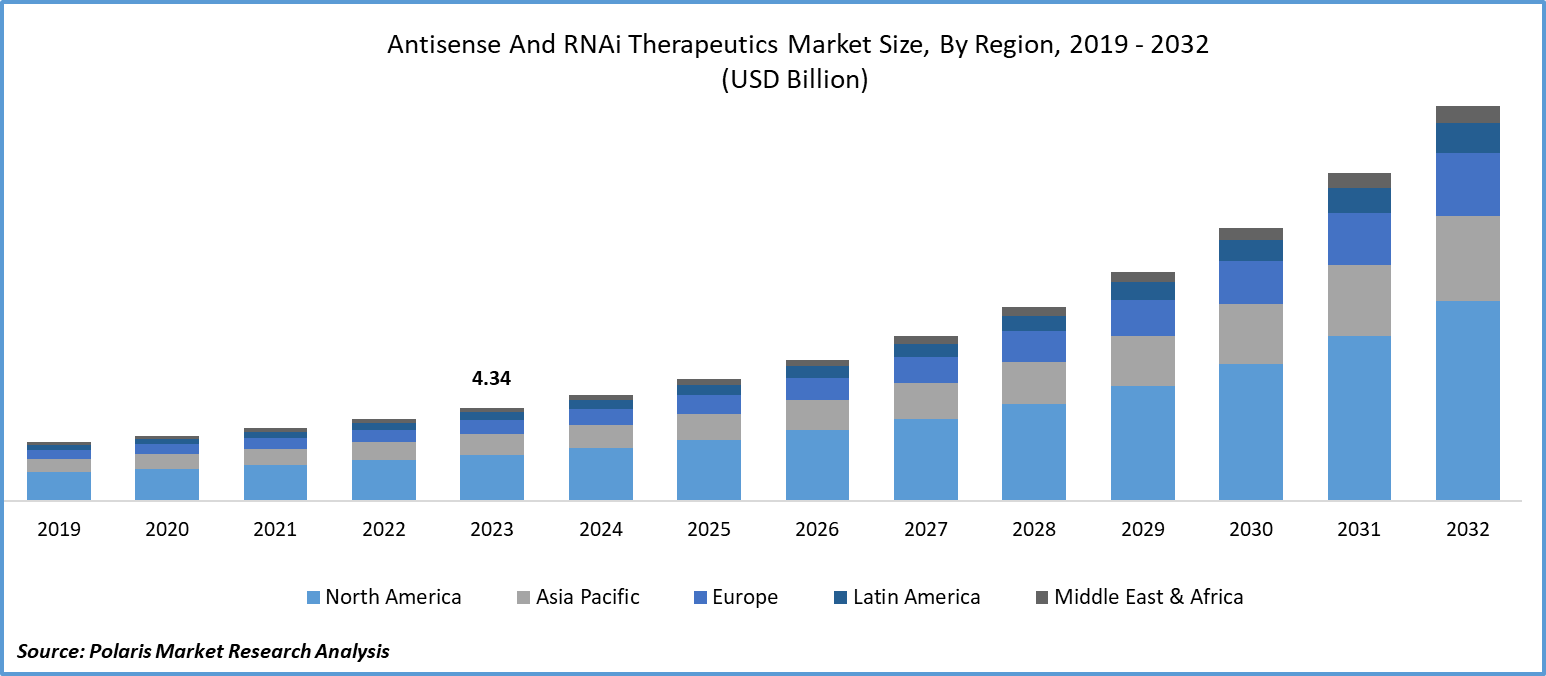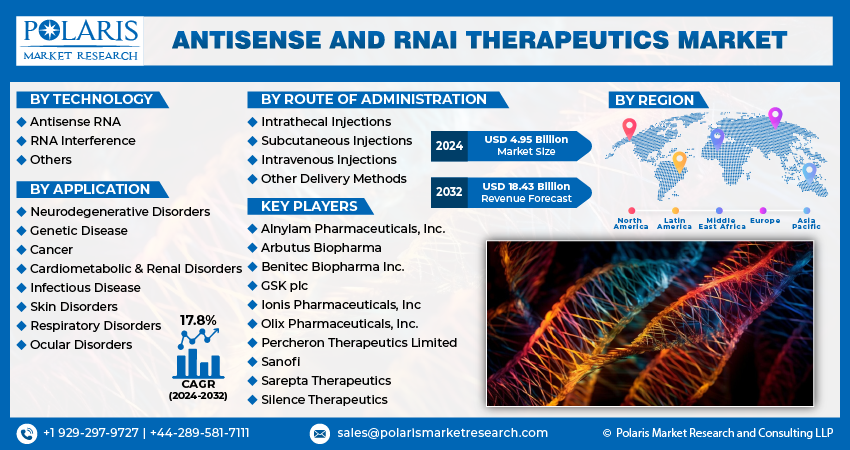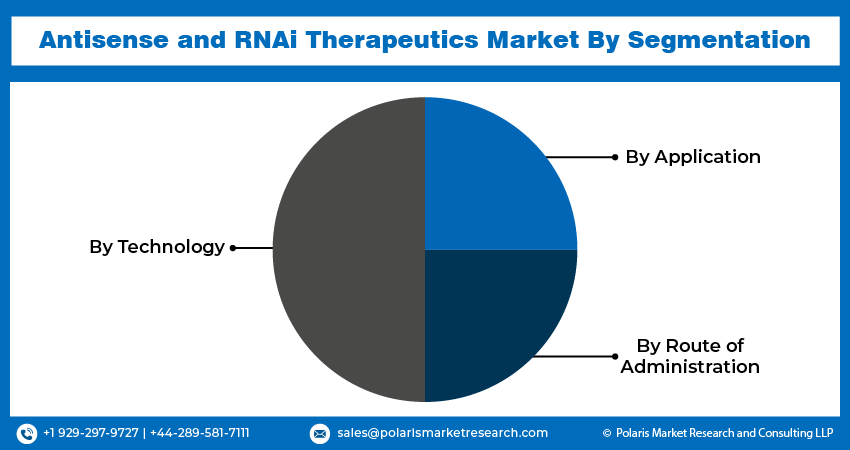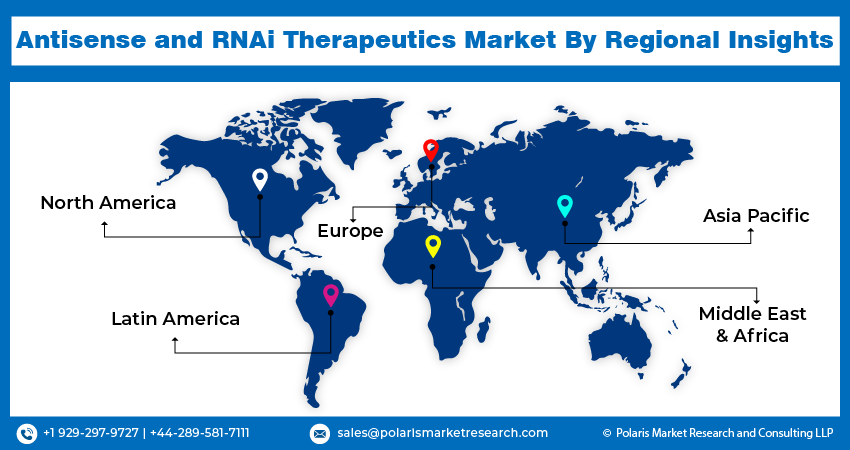
Antisense and RNAi Therapeutics Market Share, Size, Trends, Industry Analysis Report
By Technology (Antisense RNA and RNA Interference); By Route of Administration; By Application; By Region; Segment Forecast, 2024 - 2032
- Published Date:Feb-2024
- Pages: 115
- Format: PDF
- Report ID: PM4641
- Base Year: 2023
- Historical Data: 2019-2022
Report Outlook
Global antisense and RNAi therapeutics market size was valued at USD 4.34 billion in 2023. The market is anticipated to grow from USD 4.95 billion in 2024 to USD 18.43 billion by 2032, exhibiting a CAGR of 17.8% during the forecast period
Antisense and RNAi Therapeutics Market Overview
Antisense and RNA interference (RNAi) therapies are effective because they prevent the expression of genes associated with diseases. These therapies are promising for treating various medical conditions. Antisense therapy uses short strands of synthetic nucleic acids called antisense oligonucleotides (ASOs) to bind to and modify mRNA, which stops the expression of target genes. ASOs can block different stages of gene expression, such as transcription, RNA processing or transport, and translation. The key advantage of antisense therapy is its ability to reduce the expression of disease-related genes precisely. However, a major challenge is delivering ASOs to the specific tissues where they are needed.
- For instance, in August 2023, Sirnaomics Ltd declared that the organization had finished phase 1 of the clinical study for STP707, an RNAi therapeutic, which can be used in the treatment of multiple solid tumors.

To Understand More About this Research: Request a Free Sample Report
Improved therapeutic outcomes for rare diseases through the use of antisense and RNAi therapies are a primary driver driving the growth of the studied market. In addition, the market is growing due to other factors, such as the increase in R&D investment and the availability of potential pipeline items.
The COVID-19 pandemic had severe impacts on public health systems worldwide. For example, the healthcare industry faced challenges in managing the crisis. Additionally, lockdowns were implemented globally to control the spread of the virus, leading to a shortage of healthcare workers. The pharmaceutical manufacturing sector and supply chains were also disrupted. The antisense and RNAi therapeutics market growth suffered significant losses during the pandemic, as outpatient services in hospitals and clinics declined sharply. This resulted in delays or disruptions in drug infusion services for patients with rare genetic conditions such as spinal muscular atrophy (SMA), acute hepatic porphyria, and Duchenne muscular dystrophy (DMD), among others. As a result, there was a decrease in demand for antisense and RNAi therapeutics.

Antisense and RNAi Therapeutics Market Dynamics
Market Drivers
Rising focus on orphan and rare indications
RNAi and antisense therapies have shown promise in treating rare and orphan diseases like transthyretin amyloidosis (ATTR), spinal muscular atrophy (SMA), and familial chylomicronemia syndrome (FCS), which have limited treatment options. Pharmaceutical companies find these diseases attractive because they allow for early proof-of-concept and commercialization with smaller trials. The potential for orphan drug designation and associated incentives further adds to their appeal. Drugs like patisiran and inotersen have been approved for hereditary ATTR, and companies are expanding into other orphan diseases like Duchenne muscular dystrophy and hemophilia. Success in these rare diseases will likely drive progress into larger, more common conditions. This focus on orphan drug development is a key factor driving the growth of RNAi and antisense therapies.
Advancement in methods of delivering drugs
One of the key factors propelling the market development is the creation of innovative drug delivery methods for the efficient delivery of RNA interference and antisense treatments. Because conventional delivery methods, including intravenous injection, are difficult to cross cell membranes and rapidly break down by nucleases in the bloodstream, they have presented considerable obstacles to bioavailability. However, developments in material science and nanotechnology have made it possible to create sophisticated carrier systems that can both promote cellular uptake and shield oligonucleotides from deterioration.
Market Restraints
Challenges associated with the delivery of RNA Therapeutics
One major challenge in RNA therapeutic development is effectively delivering RNA compounds to their target tissues and intracellular sites of action in the body. RNA molecules degrade quickly and struggle to cross cell membranes efficiently on their own, limiting their pharmacological effectiveness. To address this, delivery technologies like nanoparticles, liposomes, and cell-penetrating peptides are used to protect RNA drugs and enhance their uptake. However, creating safe and reliable delivery systems that can withstand the body's biological environment is complex. Issues such as carriers not targeting the right tissues, immune responses, and uncertainties about encapsulation and release mechanisms are ongoing obstacles to the effective delivery of RNA drugs.
Report Segmentation
The market is primarily segmented based on technology, route of administration, application, and region.
|
By Technology |
By Route of Administration |
By Application |
By Region |
|
|
|
|
To Understand the Scope of this Report: Speak to Analyst
Antisense and RNAi Therapeutics Market Segmental Analysis
By Technology Analysis
- The antisense RNA segment held the largest antisense and RNAi therapeutics market share in 2023. Regarding revenue production, antisense RNA has dominated the market opportunity. Tests are being conducted on these compounds to regulate different situations. The use of this technology accomplishes the regulation of gene and protein expression. Additionally, it is expected that the broad use of this technology in a variety of fields, including neurological, cardiovascular, respiratory, and genetic problems, will accelerate the segment's growth. Furthermore, a number of studies are assessing antisense therapies for various illnesses.
- The RNA Interference segment is expected to grow with high CARG during the antisense and RNAi therapeutics market forecast period. This method is used to investigate gene functions in model organisms and cell cultures. Additionally, it is employed to target particular gene sequences associated with cancer. The broad applications of RNAi technology also encompass treating bacterial diseases, viruses, and parasites, as well as alleviating pain.
By Route of Administration Analysis
- The intrathecal injections segment accounted for the largest antisense and RNAi therapeutics market share in 2023 and is likely to retain its position throughout the antisense and RNAi therapeutics market forecast period. It is a method of administering medication that involves injecting it into the spinal canal or subarachnoid space to reach the CSF. This method is applied in pain management, spinal anesthetic, chemotherapy, and the introduction of medications to fight particular infections, especially following neurosurgery procedures. Every genetically modified molecule has to consider the route of medication delivery as one of its most important components.
By Application Analysis
- Based on application analysis, the market has been segmented on the basis of neurodegenerative disorders, genetic disease, cancer, cardiometabolic & renal disorders, infectious disease, skin disorders, respiratory disorders, and ocular disorders. The neurodegenerative disorder segment held a significant antisense and RNAi therapeutics market share in revenue share in 2023. Industry participants are working to advance RNAi and antisense therapies for the treatment of neurodegenerative diseases. For instance, Arrowhead Pharmaceuticals announced in June 2023 that it is seeking regulatory approval in Australia to begin studying an investigational RNA interference-based therapy in ALS patients. These initiatives by major companies focusing on neurodegenerative conditions are anticipated to drive growth in this segment.

Antisense and RNAi Therapeutics Market Regional Insights
The North American region dominated the global market with the largest antisense and RNAi therapeutics market share in 2023
The North American region dominated the global market with the largest antisense and RNAi therapeutics market share in 2023 and is expected to maintain its dominance over the anticipated period. The substantial presence of top biopharma businesses and top-notch research institutions in nations like the United States is credited with the market's rise in North America. To create cutting-edge RNAi-based treatments, several businesses have heavily invested in R&D. Antisense and RNA interference (RNAi) therapeutics are essential parts of CRISPR-based systems, with broad applications in research and potentially in treatments. Key market players in this are companies working on gene editing, biotechnology, and life sciences. Approvals for new products are likely to drive up demand for antisense and RNAi therapeutics that target genes linked to different genetic disorders.
The Europe region is expected to be the fastest-growing region, with a healthy CAGR during the projected period. It is expected that the existence of numerous businesses specializing in RNAi and antisense treatments will propel regional expansion. Furthermore, these companies are pursuing various initiatives to broaden their range of products and business opportunities.

Competitive Landscape
The market is fragmented and is anticipated to witness competition due to several players' presence. Major service providers in the market are constantly upgrading their technologies to stay ahead of the competition and to ensure efficiency, integrity, and safety. These players focus on partnership, product upgrades, and collaboration to gain a competitive edge over their peers and capture significant antisense and RNAi therapeutics market share.
Some of the major players operating in the global market include:
- Alnylam Pharmaceuticals, Inc.
- Arbutus Biopharma
- Benitec Biopharma Inc.
- GSK plc
- Ionis Pharmaceuticals, Inc
- Olix Pharmaceuticals, Inc.
- Percheron Therapeutics Limited
- Sanofi
- Sarepta Therapeutics
- Silence Therapeutics
Recent Developments
- In July 2023, Ionis Pharmaceuticals, Inc. and AstraZeneca have expanded their collaboration for jointly developing and marketing eplontersen in the U.S. AstraZeneca will have exclusive rights to market eplontersen outside the U.S., with the exception of specific Latin American countries.
Report Coverage
The Antisense and RNAi Therapeutics market report emphasizes key regions across the globe to provide a better understanding of the product to the users. Also, the report provides market insights into recent developments and trends and analyzes the technologies that are gaining traction around the globe. Furthermore, the report covers an in-depth qualitative analysis pertaining to various paradigm shifts associated with the transformation of these solutions.
The report provides a detailed analysis of the market while focusing on various key aspects such as competitive analysis, technology, route of administration, application, and their futuristic growth opportunities.
Antisense and RNAi Therapeutics Market Report Scope
|
Report Attributes |
Details |
|
Market size value in 2024 |
USD 4.95 billion |
|
Revenue Forecast in 2032 |
USD 18.43 billion |
|
CAGR |
17.8% from 2024 – 2032 |
|
Base year |
2023 |
|
Historical data |
2019 – 2022 |
|
Forecast period |
2024 – 2032 |
|
Quantitative units |
Revenue in USD billion and CAGR from 2024 to 2032 |
|
Segments Covered |
By Technology, By Route of Administration, By Application, By Region |
|
Regional scope |
North America, Europe, Asia Pacific, Latin America; Middle East & Africa |
|
Customization |
Report customization as per your requirements with respect to countries, regions, and segmentation. |
FAQ's
The Antisense and RNAi Therapeutics Market report covering key segments are technology, route of administration, application, and region.
Antisense and RNAi Therapeutics Market Size Worth $18.43 Billion By 2032
Antisense and RNAi Therapeutics Market exhibiting a CAGR of 17.8% during the forecast period
North America is leading the global market
key driving factors in Antisense and RNAi Therapeutics Market are Rising focus on orphan and rare indications
